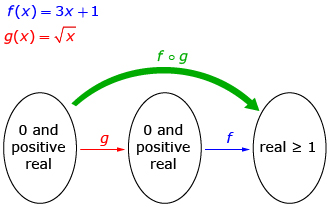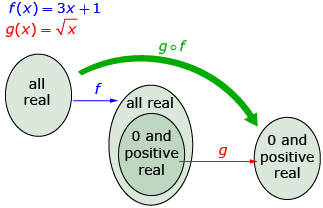Lesson 6
1. Lesson 6
1.4. Explore 3
Module 7: Rational Functions and Function Operations
When determining the domain and range of a composition of functions, you need to pay attention to what happens at each step.

The function ![]() can use only an input of 0 or positive real numbers and can give only an output of 0 or positive real numbers, so its domain is x ≥ 0 and its range is g(x) ≥0. Using 0 or positive real numbers, the function f(x) = 3x + 1 can give only an output of real numbers greater than or equal to 1. Thus, the domain of (f o g)(x) is x ≥ 0 and the range is (f o g)(x) ≥1.
can use only an input of 0 or positive real numbers and can give only an output of 0 or positive real numbers, so its domain is x ≥ 0 and its range is g(x) ≥0. Using 0 or positive real numbers, the function f(x) = 3x + 1 can give only an output of real numbers greater than or equal to 1. Thus, the domain of (f o g)(x) is x ≥ 0 and the range is (f o g)(x) ≥1.

The function f(x) = 3x + 1 has a domain of any real number and a range of any real number. However, the function ![]() can use only 0 and positive real numbers as an input and will give only 0 and positive real numbers as an output. Thus, the domain of
can use only 0 and positive real numbers as an input and will give only 0 and positive real numbers as an output. Thus, the domain of ![]() is limited to x-values that will give f(x) ≥ 0 and is
is limited to x-values that will give f(x) ≥ 0 and is ![]() The range of
The range of![]() is
is ![]()
Read “Example 2” on pages 502 and 503 of the textbook to see another example of how the domain and range can be determined for a composition of functions. Note how any domain restrictions on the inner function as well as the outer function must be taken into consideration and combined to get the domain of the composite function.